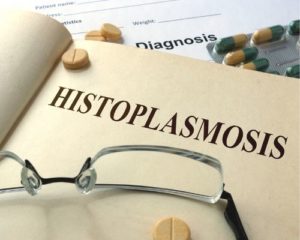Histoplasmosis | Fungal Infections of the Eye


Histoplasmosis is a fungal lung infection from the airborne spores found in bird and bat droppings. Working with soil contaminated or being in areas with bird or bat droppings puts a person at risk of developing this fungal infection which means farmers, farm laborers, landscapers, and people who spend time exploring caves are at higher risk than others. It is more common in the Mississippi and Ohio river valleys. Other areas include the mid-Atlantic and southeastern parts of the country, especially where chickens are raised.
Most of the time the infection is mild and often has no symptoms other than when catching a cold or flu. In others who have weaker immune systems, there can be joint pain and rash, and in severe infections a cough that brings up blood. In a mild infection treatment isn’t needed and your immune system will fight off the fungal infection. In severe cases, antifungal drugs are used.
Histo Spots | Ocular Histoplasmosis
In most cases, the eye does not become involved, or if it does, patients are completely unaware. When infecting the eye, spores from the fungus actually invade the retina. When involving the eye, the condition is called ocular histoplasmosis.
If you’ve had histoplasmosis it can leave tiny scars called histo spots at the infection sites. Histo spots are found in the retina, but generally they do not affect vision depending upon the location of the spots. When the macula is involved, central vision can be affected.
In some cases, abnormal blood vessels (called neovascularization) grow under the retina and cause vision loss similar to wet macular degeneration.
Any of these symptoms should prompt a call to your doctor:
- New blank spots in your central vision
- Distorted vision that makes straight lines appear bent or wavy
- Objects appear to be of different size to each eye
- Colors differ from eye to eye
Histoplasmosis Diagnosis
Your ophthalmologist will dilate your pupils to view your retina and look for the characteristic histo spots, fluid or growth of abnormal blood vessels.
Your doctor may consult a retinal specialist. Additional testing may include an OCT (optical coherence tomography), digital photography or a fluorescein angiogram to further investigate the cause of you symptoms
OCT uses near-infrared light waves to create highly magnified images of your retina and fluorescein angiography is a dye injected into a vein in your arm that will highlight the blood vessels in your retina.
Our next article will cover methods to treat ocular histoplasmosis.


